
Search
The Renewable Energy site for Do-It-Yourselfers
Cooling Without AC
|
This is a rundown on the strategy we
have worked out over the last few years for keeping the house comfortable when
outside temperatures climb up into the mid to high 90's F without using
conventional Air Conditioning. Using these techniques, our cooling bills
are less than $3 per month.
This is certainly not rocket
science, and many people have been using these common sense methods for
eons, but they were new to us, and I thought I would pass them on for
others who may not have heard of them, or believed that they could be
effective. |
|
Our summer climate in SW Montana is
characterized by highs in the 80'sF with very low humidity. Night
temperatures typically get down to the 50's and 60'sF. But, we do get a
few days in the mid to high 90's F. Even on days that get up to the mid
90's, the night temperatures almost always drop down into the low 60's F.
This climate is typical of a large
part of the western US, and the techniques we use should be helpful in these
areas. These methods will not work nearly as well in areas that do not
have cool nights and areas with high humidity -- the
cooling page may have some helpful ideas
other climates.
Cooling Strategy
This is the cooling strategy we have
evolved:
-
Reduce the solar heat gains
through windows.
-
Use good insulation levels and
low infiltration to reduce heat gains.
-
Use night ventilation to cool the
house mass when the outside temperature is low.
-
Ventilate in the morning as long
as outside temperature is lower than the inside temperature.
-
On hot day afternoons, use a
portable evaporative cooler to provide additional cooling and air
circulation.
-
Start ventilating again in the
evening when the outside temperature goes below the inside temperature.
Our usual way of ventilating is to
use our whole house fan.
This is a great tool for ventilating large areas. You open windows in
rooms that need to be ventilated, and the whole house fan pulls in air through
the open windows and exhausts it out the attic. To my way of thinking,
this is one of the best investments you can make for a home. If you are
very lucky, and have good cross ventilation and reliable winds, then the whole
house fan may not be needed, as the winds plus open windows will achieve the
same thing.
The idea is to put enough cool air
through the house at night to not only make the air comfortable, but to pull
down the temperature of the house thermal mass. This gives you a head
start on the following hot day. The reason that some homes feel hot in the
morning even though it is cool outside, is that the house mass retains the heat
from the day before.
Reducing solar heat gains through
windows was very important in our case. The house came with a huge expanse
east facing windows. The whole open plan first floor became a giant oven
through the morning. Temperatures inside the house would go well above
outside temperatures because of this heat gain. The windows also resulted
in quite a bit of glare. There was just no way to make the house
comfortable on hot days without doing something about his. The solution to
this was to replace most of this east glazing with a lightly tinted glass with a
low SHGC (Solar Heat Gain Coefficient). This greatly reduces heat gain and
glare. Last summer, we added external sun shades over the largest
area of windows to further reduce heat gain. These shades cut quite a bit
of gain while still allowing a good (but filtered) view out.
Any technique that stops the sun outside the window (e.g. outside shades, screens,
trellis, ...) will work particularly well as the sun is blocked before it gets into
the room
| |
Note: At one point in
the process of trying to figure out what to do, we were told by a local
HVAC contractor that the only way we were going to have a comfortable
home was to install a large central AC unit and run it a lot. We
were very tempted to do just that, as it was really uncomfortable on hot
days.
Controlling solar gains through windows is very important! |
|
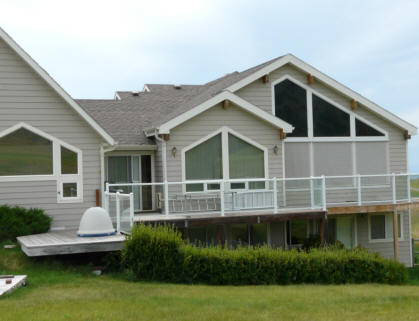
Large east windows make for very large solar heat gains.
The roll-up sun shades are visible on the lower windows. |
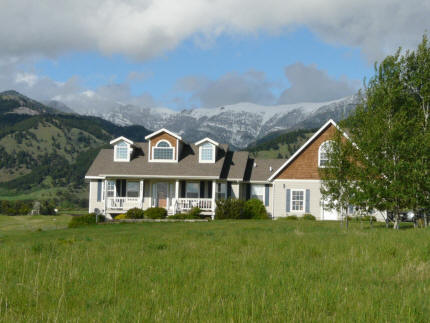
And, more solar gain on west. |
Over the past few years we have also
put quite a bit of effort into adding insulation where we could and sealing
better. These changes were mostly aimed at our space heating bill (which
is less than half what is was), but
these changes also help with cooling.
To provide some cooling for the
occasional hot day afternoon, we bought a portable (on wheels) evaporative
(swamp) cooler. This unit does a very nice job of keeping the afternoon
temperatures in the comfortable range, and providing some welcome air
circulation through the house. This unit uses about 5 gallons
of water on a hot day, so that's a negative, but the total water usage per year
is small. The outside air on the hot days has such a low relative
humidity that even though the evaporative cooler adds some water to the air, the
indoor relative humidity is still down in the 20 to 30% area.
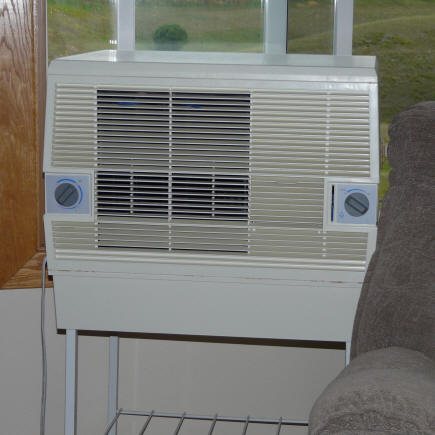
The roll-around evaporative cooler -- runs on 147 watts.
Results -- A Typical HOT Day Plot
The plot below shows some data
recorded over one of our hot days. The high for the day as measured at our
house was 95F, but official airport station for Bozeman reported 99F -- quite a
hot day for us.
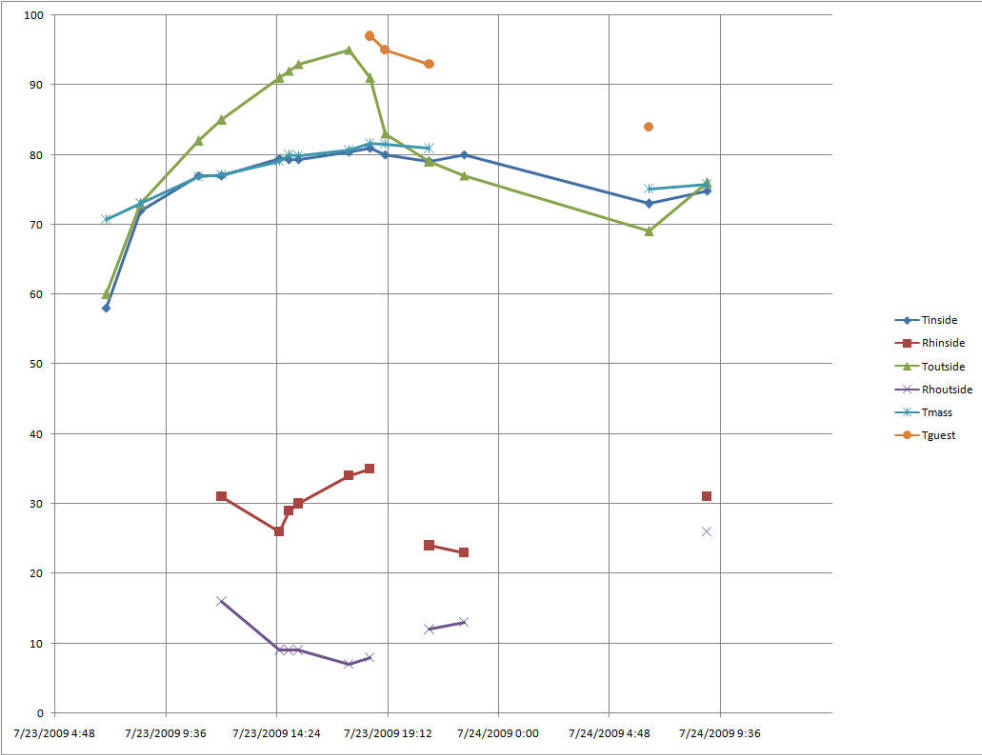
The plot starts around 5 am and goes
through one day until about 9 am the next morning.
Toutside is the outside temperature
in the shade (F).
RHoutside is the relative humidity
outside (%).
Tin is the inside temperature at the
center of the main floor (F).
RHin is the relative humidity at the
center of the main floor (%)
Tmass is the average of readings in 3
places around main floor on the sheetrock, and 1 on the fireplace stones (F).
Tup is the temperature in the
upstairs guest area (F).
We have a guest area upstairs that we
don't bother doing any sort of temperature control on. It is well
insulated, but has some south and some west window area. I show he
temperature up there just to give a rough indication what our cooling techniques
are achieving -- its a sort of "control" area.
The maximum inside temperature for
the day was
80F, which is 15F less than the maximum outside high. The maximum
temperature in the "control" guest area was actually 2F above the outside high at
97F.
The outside temperature drops to 69F
by the following morning -- this is actually higher than usual because some clouds
had moved in to reduce the cooling rate. The temperature inside the house by morning
was about 72F -- this could
have been made somewhat lower with more ventilation at night. We ran
the whole house fan about 2.5 hours during the night.
The house thermal mass starts around
70F in the morning, then rises to about 80F in mid afternoon, and then goes back down
to 75F by the next morning. If we had ventilated more during the evening,
the mass temperature would have been lower by the morning -- we did not because
the weather forecast called for cooler weather. If more hot weather is
expected, its important to get the house mass cooled well at night.
Without night ventilation, the guest
area is slow to cool off, and is still at 84F the next morning.
To me, this method keeps the house
more comfortable than a central AC would. I've never liked the feel of spaces
air conditioned with a regular AC -- not sure what it is, but the it just does
not feel very comfortable -- I've heard this same reaction from others.
So, these methods result in
comfortable indoor temperatures well below the outdoor highs. Contrast
this to the temperature in our upstairs "control" area where no steps were taken
to control the temperature. The high temperature in this area is actually
above the outside temperature for all of the hot part of the day, and its never
really cools down to a comfortable level even at night.
You might be tempted to think that we
are a tree huggers who are willing to sweat and swelter to save a few pounds of
carbon emissions. While the tree hugger part is true, the comfort levels
we achieve with these low energy methods are very comfortable indeed, and are
within the standard ASHRAE comfort zone (see chart below).
Coming from Seattle, I
would have felt a few years ago that 80F is a bit on the high side for comfort,
but with the low humidity and a little air movement it is about as comfortable
as it gets. When it gets down to 75F, I reach for a 2nd shirt to keep warm
:)
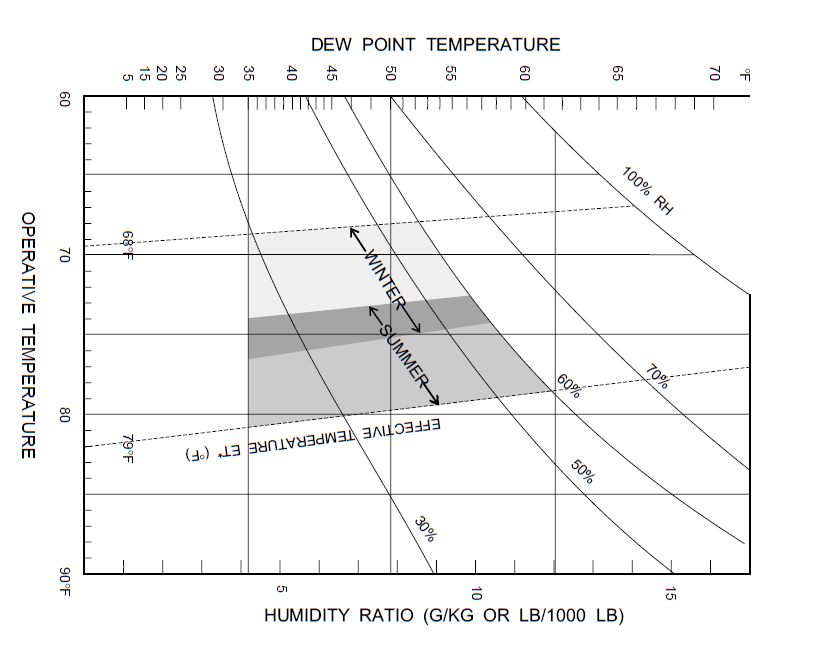
This is the ASHRAE comfort chart.
On hot days, we aim to be in the lower left corner of the comfort zone, with
inside temperature around 80F and humidity around or below 30%. We
normally have some air movement as well, which further increases comfort level.
Energy Use
Per our Kill-A-Watt meter, the
portable evaporative cooler uses 147 watts when on, and the whole house fan is
about the same at the low speed we normally use. So, if on a hot day we
run these for as much as 10 hours total, the energy use is about 1.5 KWH -- about 15
cents worth of electricity and about 2.0 lbs of CO2. Of course, most days
the run time is much lower or nothing. I suspect our monthly cooling bill
in the summer is less than $3!
Where Will These Methods Work?
I believe that even areas that get
higher day highs than we get, that the same principals can be used to provide
comfortable temperatures. You may need to pay even more attention to 1)
reducing heat gains, 2) adding more thermal mass, 3) ventilating more aggressively at
night to get the mass temperature down, and 4) using more evaporative cooling
during the hot late afternoon. Certainly worth a try anyway.
The key thing for these methods to
work is low night time temperatures and low humidity. With this kind of
climate, the average temperature for the full day is OK -- its just avoiding the
mid and late day high temperatures that you have to work on.
Gary July 25, 2009



